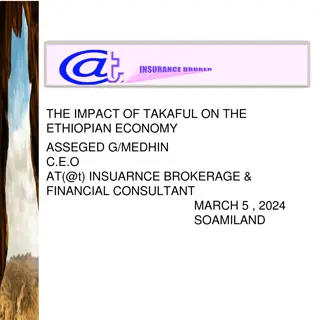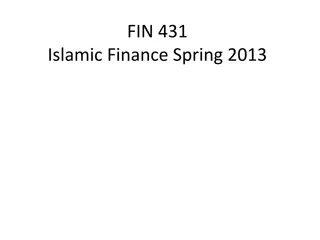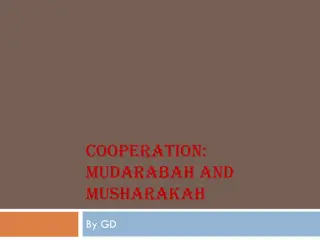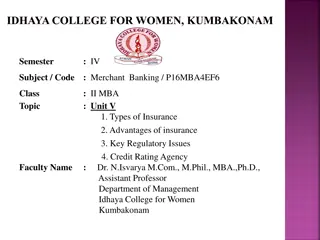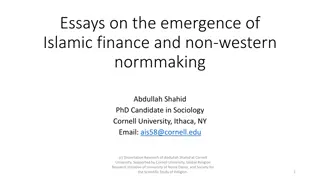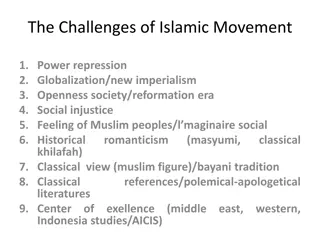Understanding Takaful and Retakaful in Islamic Insurance
Explore the workings of takaful and retakaful in Islamic insurance, including contractual relationships, principles, parties, products, models, variations, and more. Delve into the comparison with conventional insurance and current issues in this informative webinar by the Statistics Division.
Download Presentation

Please find below an Image/Link to download the presentation.
The content on the website is provided AS IS for your information and personal use only. It may not be sold, licensed, or shared on other websites without obtaining consent from the author. Download presentation by click this link. If you encounter any issues during the download, it is possible that the publisher has removed the file from their server.
E N D
Presentation Transcript
Transactions, other flows and positions in Transactions, other flows and positions in Islamic insurance (takaful and retakaful) Islamic insurance (takaful and retakaful) Webinar on the Statistical Treatment of Islamic Finance in the National and International Accounts 16 December 2021 Statistics Division
Outline How do takaful and retakaful work? Comparison of takaful and conventional insurance Current situation Issues considered and recommendations Statistics Division 2
How do takaful and retakaful work? Two contractual relationships Tabbaru contract between participants and takaful funds Contract between participants and takaful operators Fully-fledged takaful/retakaful Participants Make the payment of contribution, receive indemnities at the occurrence of the risk insured, receive a share of takaful surplus Participants Takaful fund The account established by the company to accommodate the premiums of the participants and their returns as well as the reserves Takaful Fund Takaful Operator Takaful operator The company should maintain separate accounts for the rights and liabilities of the policyholders and for its own right and liabilities Statistics Division 3
How do takaful and retakaful work? Principles Parties Products Models Surplus (+) total contributions paid (-) total indemnities paid (-) retakaful operations, expenses and changes in technical provisions reallocated to participants mutual assistance participants general takaful Mudarabah- based takaful fund donations commitment family takaful Wakala- based takaful operators cooperative risk-sharing Re-takaful hybrid model Waqf takaful Statistics Division 4
How do takaful and retakaful work? Two other variations Light takaful Takaful windows That part of a conventional financial institution that provide takaful or retakaful services May be a branch or a dedicated unit of that institution Have separately identified assets and liabilities Contracts are not based on tabarru principles No segregation of takaful operators and takaful funds Statistics Division 5
Comparison of takaful and conventional insurance Conventional insurance Takaful The company is an original party that signs the contract in its own name The company assumes the role of the agent of the insurance account The company owns the premiums against its commitment to pay the insurance amount The insurance account rather than the company owns the contributions The company owns and receives the premiums as soon as it signs the contract. The premiums and returns on them constitute part of the revenue and profits of the company. The returns on investment of premiums belong to the policyholders account, after deduction of the Mudarib share for the company. The residual premiums and the returns on them, become also the property of the policyholders account, and constitute a surplus, which can be distributed among the policyholders. The insurer and the participant are in fact the same person although they differ in recognition The insurer and the participant are totally different Statistics Division 6
Current situation 2008 SNA and BPM6 provide recommendations to record conventional insurance transactions, other flows and positions Both do not have explicit recommendations for the treatment of takaful and retakaful activities Statistics Division 7
Issues considered and recommendations Are they institutional units (issue 6.1)? Sectorization (issue 6.2) Financial auxiliaries (S126) Insurance corporations (S128) Insurance corporations (S128) Insurance corporations (S128) Methods to calculate output (issue 6.3) Fees charged and/or the share of profits earned from investing the funds Entity Takaful/retakaful operators Yes Takaful/retakaful funds Yes Sum of costs Conventional insurance formula in 2008 SNA Light takaful Yes Takaful windows Yes Sum of costs Statistics Division 8
Thank you for your attention Statistics Division








